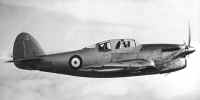- Hawker Henley
infobox Aircraft
name = Hawker Henley
type =Target tug
manufacturer =Hawker 
designer =Sydney Camm
first flight =10 March 1937
introduced = 1938
retired = 1942
primary user =Royal Air Force
number built = 200
variants with their own articles =Hawker Hotspur The Hawker Henley was a British two-seat target tug derived from the
Hawker Hurricane that was operated by the RAF during the Second World War.Design and development
In 1934 Britain’s
Air Ministry issued Specification P.4/34 which called for a light bomber that could also be deployed in a close-support role.Fairey ,Gloster andHawker all rushed to fulfill this need, and competition was tight to attain the highest performance possible.Seeing as the aircraft required only a modest bomb load, and with performance being paramount, the Hawker design team chose to focus its efforts on developing an aircraft similar in size to the Hurricane fighter. The Hurricane itself was then in an advanced design stage, and it was thus beneficial both economically and production-wise if some assemblies could be common to both aircraft. This resulted in the Henley, as it was to become known, sharing identical outer wing panel and tailplane jigs with the Hurricane. Both were also equipped with the
Rolls-Royce Merlin engine as it offered the best power/weight ratio as well as a minimal frontal area. The Henley’s cantilever fabric-covered monoplane wing was mid-set, retractable tailwheel type landing gear was selected, and accommodation provided for a pilot and observer/air gunner, which differed from the Hurricane’s single-seat accommodation.Although construction of a Henley prototype began as early as mid-1935, with all priorities going to Hurricane development it was not until
10 March 1937 that it was first flown, powered by a Merlin "F" engine; shortly after the competingFairey P.4/34 Subsequently the aircraft was refitted with light alloy stressed-skin wings and a Merlin I engine, and further test flights confirmed the excellence of its overall performance. However, the Air Ministry had by this point decided that it no longer required a light bomber, and the Henley was thus re-designated as a target tug. Henley production was subcontracted to Gloster Aircraft, and 200 were ordered into production. The second prototype was fitted with a propeller-driven winch to haul in the drogue cable after air-to-air firing sorties, in recognition of its new role, and was first flown on26 May 1938 .Operational history
Production aircraft, designated Henley III, entered service with Nos. 1, 5 and 10 Bombing and Gunnery Schools, as well as with the Air Gunnery Schools at Barrow, Millom and Squires Gate. Unfortunately, it was soon discovered that unless the aircraft were restricted to an unrealistically low tow speed of 220 mph (355 km/h), the rate of engine failures was unacceptably high. This resulted in Henleys being withdrawn from this role and relegated to towing larger drogue targets with anti-aircraft co-operation units. Predictably, the Henley proved to be even more unsuited to this role, and the number of engine failures increased. Several Henleys were lost after the engine cut-out and the drogue could not be released quickly enough. A solution was never found to this problem, and in mid-1942 the Henley was withdrawn from service, and replaced by
Boulton Paul Defiant s, as well as purpose-builtMiles Martinet s. [Gunston 1995]Variants
;Henley I:Prototype.;Henley II:Second prototype.;Henley III:Two-seat target tug aircraft for the RAF, 200 built.;
Hawker Hotspur :Prototype two seater fighter variant of the Henley with a four-gun power-driven turret. This did not reach production, the requirement being met by the Defiant and theBlackburn Roc .Operators
;UK
*Royal Air Force
**No. 264 Squadron RAF
**No. 266 Squadron RAF
**No. 291 Squadron RAF
**No. 587 Squadron RAF
**No. 595 Squadron RAF
**No. 631 Squadron RAF
**No. 639 Squadron RAF
**No. 679 Squadron RAF
**No. 695 Squadron RAF pecifications (Henley Mk III)
aircraft specifications
plane or copter?=plane
jet or prop?=prop
ref=
crew=2
capacity=
payload main=
payload alt=
length main= 36 ft 5 in
length alt= 11.10 m
span main= 47 ft 10½ in
span alt= 14.59 m
height main= 14 ft 7½ in
height alt= 4.46 m
area main= 342 ft²
area alt= 31.77 m²
airfoil=
empty weight main= 6,010 lb
empty weight alt= 2,726 kg
loaded weight main=
loaded weight alt=
useful load main=
useful load alt=
max takeoff weight main= 8,840 lb
max takeoff weight alt= 3,846 kg
more general=
engine (prop)=Rolls-Royce Merlin II
type of prop=inline piston engine
number of props=1
power main= 1,030 hp
power alt= 768 kW
power original=
max speed main= (with drogue) 272 mph at 17,500 ft
max speed alt= 438 km/h at 5,300 m
cruise speed main= 235 mph at 15,000 ft
cruise speed alt= 378 km/h at 4,500 m
stall speed main=
stall speed alt=
never exceed speed main=
never exceed speed alt=
range main= 950 miles
range alt= 1529 km
ceiling main= 27,000 ft
ceiling alt= 8,200 m
climb rate main= 1,150 ft/min
climb rate alt= 340 m/min
loading main= 25.9 lb/ft²
loading alt= 121 kg/m²
thrust/weight=
power/mass main= 0.121 hp/lb
power/mass alt= 0.200 kW/kg
more performance=
armament=
avionics=ee also
aircontent
sequence=
related=
*Hawker Hotspur
similar aircraft=
*Hawker Hotspur
*Hawker Hurricane
*Fairey Battle
lists=
see also=
*Boulton Paul Defiant
*Blackburn Roc References
Notes
Bibliography
* Cooper, H.J.; Thetford, O.G. and Maycock, C.B. "Aircraft of the Fighting Powers - Volume II". Leicester, UK: Harborough Publishing, 1942.
* Gunston, Bill. "Classic World War II Aircraft Cutaways." London: Osprey, 1995. ISBN 1-85532-526-8.
* Hannah, Donald. "Hawker FlyPast Reference Library". Stamford, Lincolnshire, UK: Key Publishing Ltd., 1982. ISBN 0-946219-01-X.
* James, Derek N. "Hawker, an Aircraft Album No. 5". New York: Arco Publishing Company, 1973. ISBN 0-668-02699-5. (First published in the UK by Ian Allan in 1972)
* Mason, Francis K. "Hawker Aircraft since 1920". London: Putnam, 1991. ISBN 0-85177-839-9.
* Mondey, David. "The Hamyln Concise guide to British aircraft of World War II". London: Hamlyn/Aerospace, 1982. ISBN 0-600-34951-9.External links
* [http://www.jaapteeuwen.com/ww2aircraft/html%20pages/HAWKER%20HENLEY.htm British Aircraft of World War II - Hawker Henley]
* [http://www.csd.uwo.ca/Elevon/ gustin_military/db/br/HENLEYHA.html Hawker Henley]
Wikimedia Foundation. 2010.
